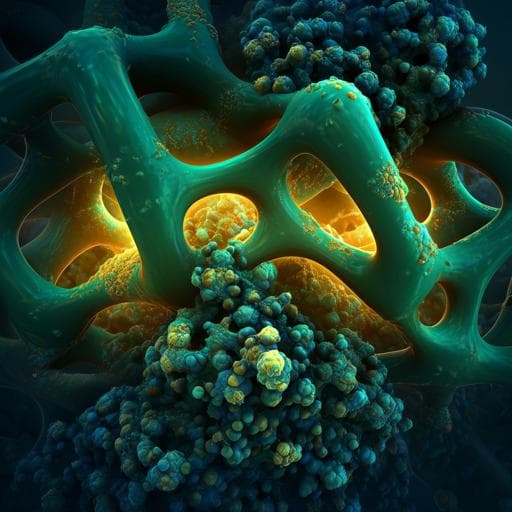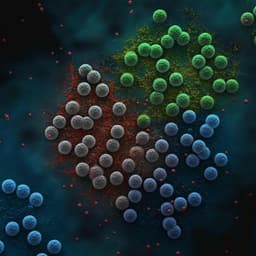
Medicine and Health
Neoadjuvant pembrolizumab, dabrafenib and trametinib in BRAFV600-mutant resectable melanoma: the randomized phase 2 Neo Trio trial
G. V. Long, M. S. Carlino, et al.
In a groundbreaking phase 2 trial, researchers explored the impact of combining targeted therapy with immunotherapy for patients with resectable stage III BRAFV600-mutant melanoma. Conducted by a team including Georgina V. Long and Matteo S. Carlino, the study uncovered crucial insights into treatment efficacy and recurrence rates, challenging the notion of enhanced benefits from combined therapies.
~3 min • Beginner • English
Introduction
The study addresses whether adding short-course BRAF/MEK-targeted therapy to neoadjuvant anti–PD-1 immunotherapy improves outcomes in resectable stage III BRAF V600-mutant melanoma. Approximately 40% of cutaneous melanomas harbor BRAF mutations and respond well to BRAF/MEK inhibitors but often relapse within 2 years, whereas immune checkpoint inhibitors (ICIs) yield lower initial response rates but more durable control. Preclinical and translational data show that BRAF/MEK inhibition can increase tumor-infiltrating lymphocytes and PD-L1 expression, suggesting potential synergy with PD-1 blockade. However, optimal timing and combination remain uncertain. NeoTrio evaluates anti–PD-1 alone versus sequential or concurrent addition of dabrafenib plus trametinib during the 6-week neoadjuvant window, with the hypothesis that targeted therapy could enhance pathologic response and translate into superior recurrence-free outcomes.
Literature Review
Prior randomized trials in advanced BRAF-mutant melanoma (KEYNOTE-022, COMBI-i, IMspire150) showed that adding anti–PD-1/PD-L1 to BRAF/MEK targeted therapy prolonged progression-free survival but at the cost of substantially increased toxicity. Sequencing trials (SECOMBIT, DREAM-seq) favored initiating with combination ICI (anti–PD-1 plus anti–CTLA-4) followed by targeted therapy at progression. In the neoadjuvant setting, pooled analyses reported pCR rates of ~47% with BRAF-targeted therapy and ~33% with ICI (20% with anti–PD-1 monotherapy; 43% with anti–PD-1 plus anti–CTLA-4). Importantly, durability favored ICI: 2-year RFS was ~96% for any pathologic response to ICI versus 79% for pCR to targeted therapy, and NeoCombi did not show neoadjuvant targeted therapy superiority over adjuvant targeted therapy. SWOG S1801 demonstrated improved 2-year EFS (72% vs 49%) with neoadjuvant plus adjuvant pembrolizumab compared with adjuvant-only pembrolizumab. These data motivated testing whether integrating targeted therapy with neoadjuvant anti–PD-1 could improve deep responses and long-term control.
Methodology
Design: NeoTrio (NCT02858921) was a randomized, multi-arm, open-label, parallel, non-comparative phase II trial in Australia evaluating neoadjuvant pembrolizumab with or without dabrafenib plus trametinib in resectable stage III BRAF V600-mutant melanoma.
Participants: Adults ≥18 years with histologically confirmed resectable AJCC 8th edition stage IIIB–D cutaneous or unknown primary melanoma with nodal involvement, measurable disease by RECIST v1.1, confirmed BRAF V600 mutation, ECOG 0–1, and adequate organ function. Unresected primary melanoma was allowed. Conducted at Westmead Hospital, Melanoma Institute Australia, and Peter MacCallum Cancer Centre. Ethics approvals obtained; written informed consent required.
Randomization/stratification: 1:1:1 via web-based permuted blocks (sizes 6, 9), stratified by BRAF V600E vs non-V600E (V600K/R/D/M).
Interventions (6-week neoadjuvant period):
- Pembrolizumab monotherapy: Pembrolizumab 200 mg IV on days 1 and 22.
- Sequential therapy: Dabrafenib 150 mg PO BID + trametinib 2 mg PO QD for 7 days (days 1–7), then pembrolizumab 200 mg IV on days 8 and 22.
- Concurrent therapy: Dabrafenib 150 mg PO BID + trametinib 2 mg PO QD continuously for 6 weeks with pembrolizumab 200 mg IV on days 1 and 22.
Surgery: Therapeutic lymph node dissection between days 42–56 (some at week 12 before protocol amendment aligning to INMC guidance). Resectability assessed at baseline and within 24 h postoperatively.
Adjuvant therapy: Planned 42 weeks (16 doses) of pembrolizumab Q3W starting as soon as feasible post-surgery, until toxicity, withdrawal, recurrence, or death. For patients with pathological non-response (pNR) after neoadjuvant therapy, adjuvant dabrafenib plus trametinib for 52 weeks could be selected per investigator outside the protocol.
Assessments: Baseline CT, MRI, FDG-PET; CT every 6 weeks pre-surgery then every 12 weeks; FDG-PET at weeks 6 and 48. Tumor biopsies at baseline, day 8, day 15; resection specimen at week 6. Blood for biomarkers at baseline, days 8 and 15, day 42 (pre-surgery), and at progression/recurrence; stool for microbiome at baseline, pre-surgery, week 24, and at progression/recurrence. HRQOL with EORTC QLQ-C30 every 6 weeks (to week 60) and FACT-M postsurgery. Safety monitored continuously; surgical outcomes captured to 4 weeks postsurgery. Survival follow-up every 12 weeks up to 10 years.
Endpoints: Primary—pathological response rate at week 6 (pCR + near-pCR + pathological partial response) and pCR rate by central pathology using INMC criteria. Secondary—RECIST v1.1 response at week 6, recurrence-free survival (RFS from surgery), overall survival (OS), event-free survival (EFS from treatment start), surgical outcomes, safety, HRQOL, translational biomarker analyses. Other prespecified endpoint—metabolic response by EORTC PET at week 6.
Statistics: Each arm powered as a single-arm design to test pathological response rate ≤5% vs ≥20% (A’Hern single-stage exact design). Sample size: 20 per arm (total 60). Three or more pathological responses rejected ≤5% response hypothesis (target error 0.080; actual 0.075); ≤2 responses rejected ≥20% hypothesis (target error 0.210; actual 0.206). Intention-to-treat population included all patients receiving ≥1 pembrolizumab dose. Response rates summarized with exact 95% CIs. Time-to-event outcomes analyzed by Kaplan–Meier; landmark rates reported at 12 and 24 months (up to 3 years). No formal arm-to-arm statistical comparisons. HRQOL analyzed via mixed linear models with two-sided P ≤ 0.05 for significance and interpretation against MCID thresholds.
Key Findings
Participants: 63 screened; 60 enrolled and randomized (20 per arm). Median age 53 (IQR 42–63); 42% female. BRAF mutation: V600E 82%, V600K 15%, V600R 3%. Nodal disease: N1b 63%, N2b 20%, N3b 17%.
Treatment exposure and surgery: 85% completed neoadjuvant therapy; 15% discontinued early due to neoadjuvant TRAEs (concurrent 40% (8/20), sequential 0%, pembrolizumab 5% (1/20)). Surgery performed in 57/60 (95%); 3 (5%) had distant progression precluding surgery. Postoperative adjuvant therapy: 45 (75%) pembrolizumab; 5 (8%) adjuvant dabrafenib+trametinib (after pNR); 7 (12%) no adjuvant therapy.
Primary endpoint—pathologic response at week 6: Met in all arms.
- Any pathological response: pembrolizumab 55% (11/20; 95% CI 36–83), sequential 50% (10/20; 27–73), concurrent 80% (16/20; 60–97).
- pCR: pembrolizumab 30% (6/20), sequential 15% (3/20), concurrent 50% (10/20).
- MPR (pCR or near-pCR): pembrolizumab 40% (8/20), sequential 30% (6/20), concurrent 55% (11/20).
- pNR: pembrolizumab 35% (7/20), sequential 50% (10/20), concurrent 15% (3/20).
Radiographic response (RECIST v1.1) at week 6: ORR (CR+PR) pembrolizumab 30% (6/20), sequential 50% (10/20), concurrent 70% (14/20). RECIST PD in 12% overall (pembro 25%, sequential 5%, concurrent 5%). MPR observed in 70% of RECIST CR, 55% of PR, 30% of SD, and 0% of PD.
Metabolic response (EORTC PET) at week 6: CMR/PMR observed in pembrolizumab 40% (8/20), sequential 50% (10/20), concurrent 95% (19/20). CMR in 1, 1, and 5 patients respectively. CMR was specific but insensitive for MPR; PMD was specific but insensitive for pNR.
Survival (landmark rates):
- EFS at 12/24 months: pembrolizumab 80%/60%; sequential 80%/80%; concurrent 80%/71%.
- RFS at 12/24 months: pembrolizumab 89%/66%; sequential 80%/80%; concurrent 84%/75%.
- OS at 12/24 months: pembrolizumab 94%/76%; sequential 95%/89%; concurrent 95%/95%. Events to cutoff: EFS events 9/9/6 (text) and table indicates 7/8/5; RFS events 6/8/5; deaths 4/3/2 (text) and table shows deaths to cutoff 3/3/1—deaths attributable to melanoma following progression/recurrence.
Prognostic value of pathologic response: Higher RFS with MPR vs non-MPR. No MPR patient recurred in the pembrolizumab arm; one MPR recurrence in each targeted therapy arm. Pathological response at week 6 predicted RFS better than RECIST or PET responses.
Safety: Any-grade TRAEs during the study occurred in 85% (pembro), 95% (sequential), 100% (concurrent). During neoadjuvant period: any-grade TRAEs 75%, 80%, 100%; grade 3/4 TRAEs 5%, 5%, 40% respectively. Overall grade 3/4 TRAEs: 5% (1/20), 25% (5/20), 55% (11/20). Neoadjuvant treatment discontinuations due to TRAEs: 0, 0, 7 (35%). Treatment interruptions during neoadjuvant therapy: sequential 3 (for D/T) and concurrent 19 (for D/T/pembrolizumab); pyrexia most common AE (21 patients; 17 in concurrent arm), followed by fatigue, rash, pruritis, vitiligo, headache, nausea. Surgery-related AEs were less frequent in the concurrent arm (any-grade 42%) vs pembrolizumab (83%) and sequential (80%).
Surgical/resectability outcomes: Resection assessed as easier than baseline more often in the concurrent arm (47%) vs sequential (21%) and pembrolizumab (12%); however, overall no clear association when stratified by pathological response. Neck basin resections were more often harder than expected. HRQOL: Deterioration at week 6 in concurrent arm (perioperative), and at week 12 postsurgery in pembrolizumab and sequential arms; only pembrolizumab at week 12 reached clinically significant deterioration.
Discussion
The trial tested whether adding BRAF/MEK targeted therapy to neoadjuvant anti–PD-1 improves outcomes in resectable BRAF V600-mutant melanoma. Although concurrent therapy yielded the highest week-6 pathological response and radiographic/metabolic responses, durability signals did not improve and toxicity markedly increased. Importantly, pathologic response quality appeared diminished with targeted therapy: among patients achieving MPR, recurrences occurred only in the targeted therapy arms within the current follow-up, while no MPR patient recurred in the pembrolizumab monotherapy arm. Pathologic response correlated strongly with RFS and outperformed RECIST and PET responses as a surrogate, supporting its use for early decision-making in neoadjuvant trials. The lack of synergy with short-course induction targeted therapy (sequential arm) mirrors metastatic data (SECOMBIT), suggesting immune infiltrates induced by BRAF/MEK inhibition may not translate into tumor-specific, durable anti–PD-1 augmentation and may share resistance pathways (e.g., MAPK, PTEN). Given substantial grade 3/4 toxicity and discontinuation with triple therapy, and absent clear survival benefit at 2 years, combining targeted therapy with neoadjuvant anti–PD-1 is not supported. Future strategies should focus on improving outcomes for pathological non-responders to ICI and on biomarker-driven approaches.
Conclusion
Neoadjuvant pembrolizumab alone, sequentially with, or concurrently combined with dabrafenib plus trametinib achieved substantial pathological responses in resectable stage III BRAF V600-mutant melanoma, meeting the primary endpoint in all arms. Despite higher pathologic response rates with concurrent therapy, increased toxicity and signs of reduced response durability (recurrences among MPRs) argue against adding BRAF/MEK inhibitors to neoadjuvant anti–PD-1. Pathologic response at week 6 best predicted RFS versus imaging-based metrics. Pending longer follow-up, the data suggest neoadjuvant ICI should not be combined with targeted therapy in this setting. Future research should prioritize strategies for immunotherapy non-responders, including novel immune combinations (e.g., anti–LAG-3) and biomarker-informed treatments, and explore mechanisms of cross-resistance.
Limitations
The non-comparative phase II design was not powered for formal statistical comparisons between arms, limiting inference regarding superiority. The small sample size (n=20 per arm) reduces precision of estimates and may obscure long-term survival and HRQOL trends. Median follow-up of 24.5 months may be insufficient to fully capture late recurrences, particularly relevant to targeted therapy. HRQOL analyses were censored at 60 weeks due to small numbers. Some protocol heterogeneity existed early (surgery at 7–12 weeks before amendment), though no imbalances in outcomes were observed.
Related Publications
Explore these studies to deepen your understanding of the subject.







